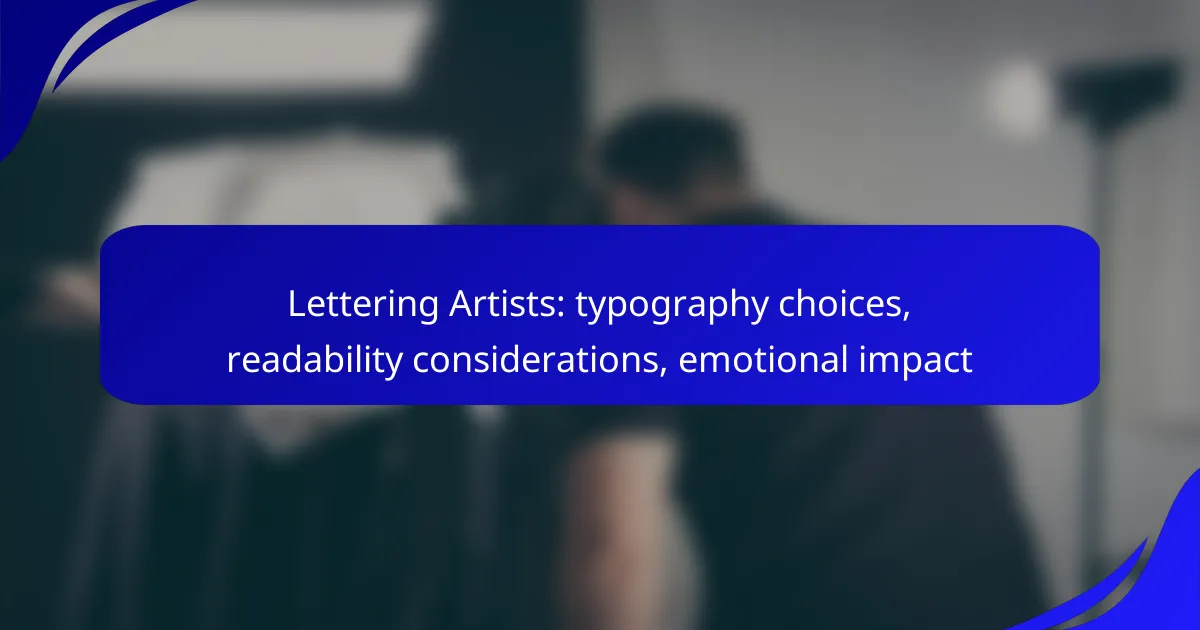Lettering artists play a vital role in enhancing communication through their careful typography choices, which directly affect readability and emotional resonance. By considering factors such as font style, contrast, size, and spacing, they ensure that their designs are not only visually appealing but also easily understood. Additionally, the emotional impact of typography can significantly shape how a message is perceived, making it essential for artists to align their typefaces with the intended tone and context.
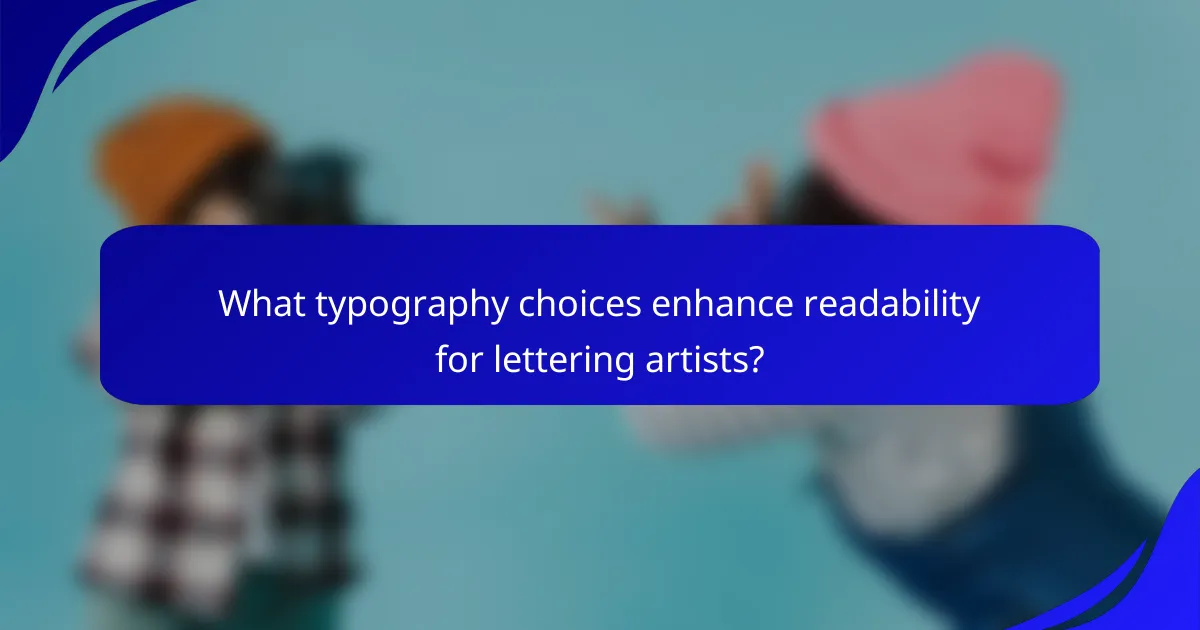
What typography choices enhance readability for lettering artists?
Lettering artists can enhance readability by selecting typography that is clear and legible. Key choices include font style, contrast, size, and spacing, all of which play a crucial role in how easily text can be read and understood.
Sans-serif fonts for clarity
Sans-serif fonts are often favored for their clean and modern appearance, making them highly readable. Fonts like Arial, Helvetica, and Futura lack the decorative strokes found in serif fonts, which can distract the reader. When aiming for clarity, especially in digital formats, sans-serif options are typically the best choice.
Consider using sans-serif fonts for headings and body text in designs where quick comprehension is essential. Their straightforward nature ensures that the message is conveyed without unnecessary embellishments.
Contrast and color selection
High contrast between text and background is vital for readability. Using dark text on a light background or vice versa helps ensure that the letters stand out clearly. Avoid using colors that are too similar, as this can strain the eyes and reduce legibility.
When selecting colors, consider accessibility standards, such as ensuring sufficient contrast ratios. Tools are available to help check color combinations, ensuring that your typography remains readable for all audiences.
Font size and spacing considerations
Font size significantly impacts readability; generally, a size of at least 12 points is recommended for body text. Larger sizes are preferable for headings to create a clear visual hierarchy. Additionally, adequate line spacing (1.5 to 2 times the font size) can enhance readability by preventing the text from feeling cramped.
Pay attention to letter spacing as well, especially in decorative fonts. Slightly increasing the spacing can improve legibility, particularly at smaller sizes or when using intricate designs.
Using hierarchy for emphasis
Establishing a clear hierarchy in typography helps guide the reader’s eye through the text. Use different font sizes, weights, and styles to distinguish headings, subheadings, and body text. This not only enhances readability but also allows the most important information to stand out.
For example, using bold for headings and regular weight for body text can create a clear distinction. Incorporating visual cues like italics or underlining can further emphasize key points, making the overall message more engaging and easier to follow.
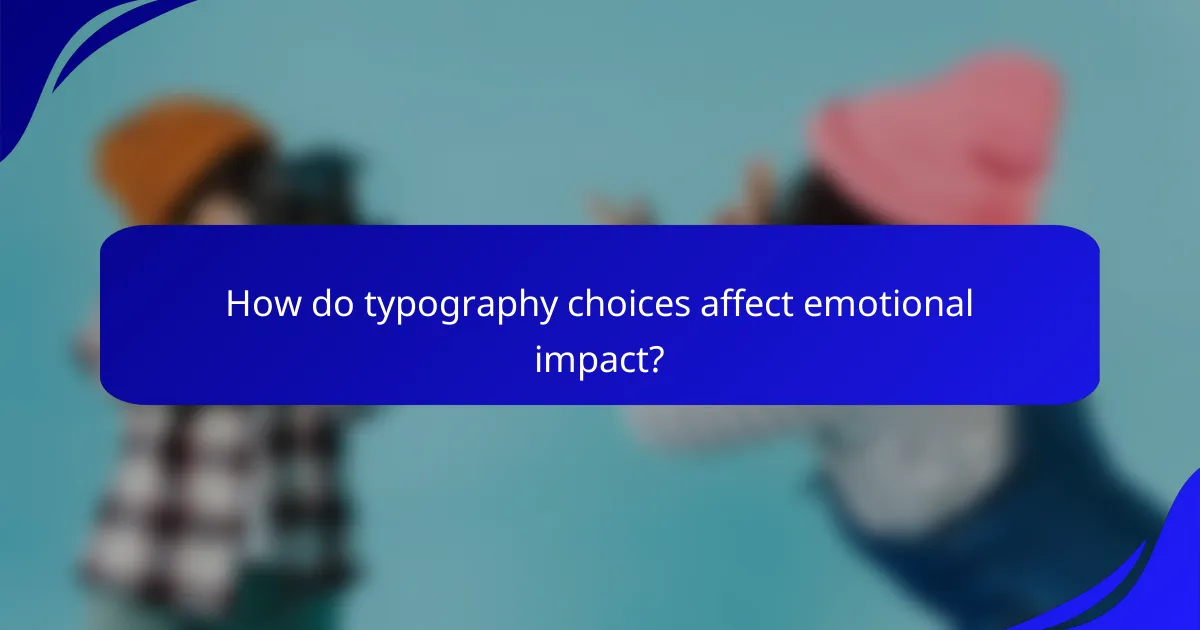
How do typography choices affect emotional impact?
Typography choices significantly influence emotional impact by shaping how a message is perceived. Different font styles can evoke various feelings and associations, making it essential to select typefaces that align with the intended tone and message.
Serif fonts evoke tradition
Serif fonts, characterized by their small lines or decorative strokes at the ends of letters, often convey a sense of tradition and reliability. They are commonly used in print media, such as books and newspapers, where a classic aesthetic is desired. Examples include Times New Roman and Georgia, which can create an authoritative or formal atmosphere.
When using serif fonts, consider the context of your message. They work well for brands that want to project stability, such as law firms or educational institutions. However, overuse in modern digital contexts may make content feel outdated.
Bold typography conveys strength
Bold typography is effective for conveying strength and confidence. By increasing the weight of the font, it draws attention and emphasizes key messages. This style is often used in advertising and headlines to create a strong visual impact.
When selecting bold fonts, ensure they are legible at various sizes and on different backgrounds. Popular bold typefaces include Impact and Arial Black. Use bold sparingly to avoid overwhelming the reader, focusing on essential points that need emphasis.
Script fonts suggest elegance
Script fonts mimic handwritten text and often suggest elegance and sophistication. They are frequently used for invitations, branding, and luxury products, where a personal touch is desired. Examples include Brush Script and Pacifico, which can evoke feelings of warmth and intimacy.
While script fonts can enhance the emotional appeal of a design, they should be used judiciously. Ensure readability, especially in longer texts, and avoid using them in body copy. Pairing script fonts with simpler sans-serif or serif fonts can create a balanced and visually appealing design.
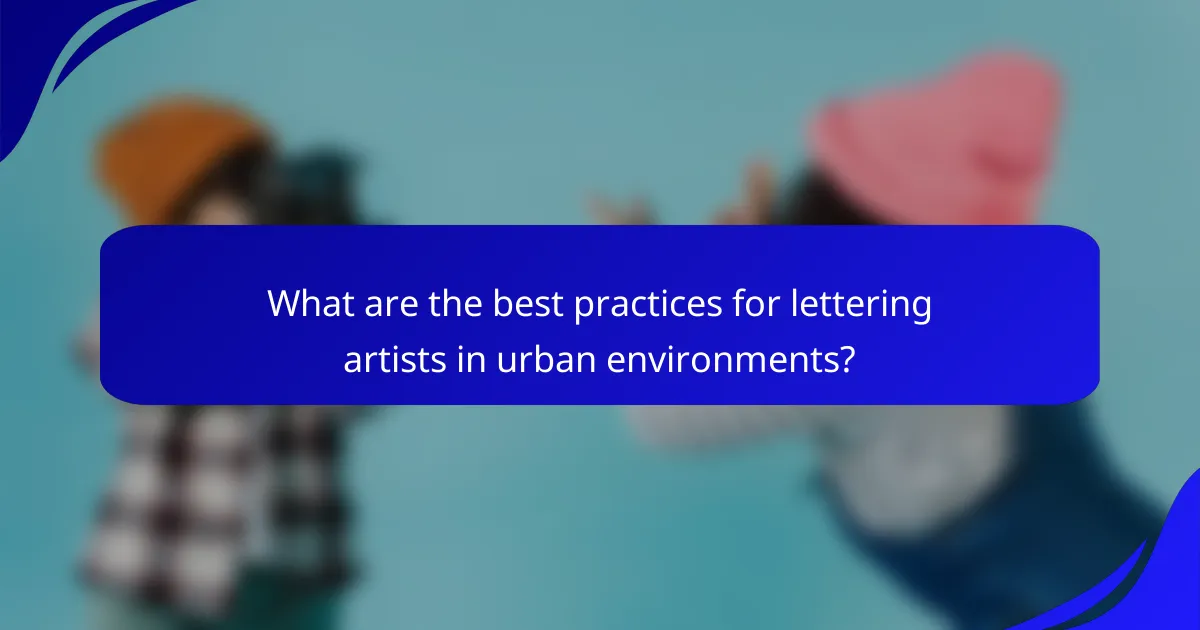
What are the best practices for lettering artists in urban environments?
Lettering artists in urban environments should prioritize readability and emotional impact while adapting their typography to fit the local culture. Effective designs resonate with the community and enhance the visual landscape, making art accessible and engaging for all passersby.
Adapting styles for street art
When creating street art, lettering artists must consider the scale and visibility of their typography. Bold, clear fonts tend to work best in urban settings, where quick readability is essential. Artists should experiment with styles that reflect the energy of the environment, such as graffiti-inspired lettering or playful script fonts.
Additionally, contrasting colors can enhance visibility against various backgrounds. Artists should test their designs from different distances to ensure that their work remains legible and impactful.
Using typography in branding
Typography plays a crucial role in branding, especially in urban areas where competition is fierce. Lettering artists should choose fonts that align with the brand’s identity and values while ensuring they are easily readable from a distance. Sans-serif fonts often convey modernity, while serif fonts can evoke tradition and reliability.
It’s important to maintain consistency across various branding materials, including signage, packaging, and promotional items. This creates a cohesive visual identity that strengthens brand recognition among urban consumers.
Integrating local culture into designs
Incorporating local culture into lettering designs can significantly enhance their emotional impact. Artists should research local history, symbols, and community values to create designs that resonate with residents. This might include using regional dialects, iconic landmarks, or cultural motifs.
Collaborating with local artists or community groups can provide valuable insights and foster a sense of ownership among residents. Such engagement not only enriches the artwork but also promotes community pride and connection.
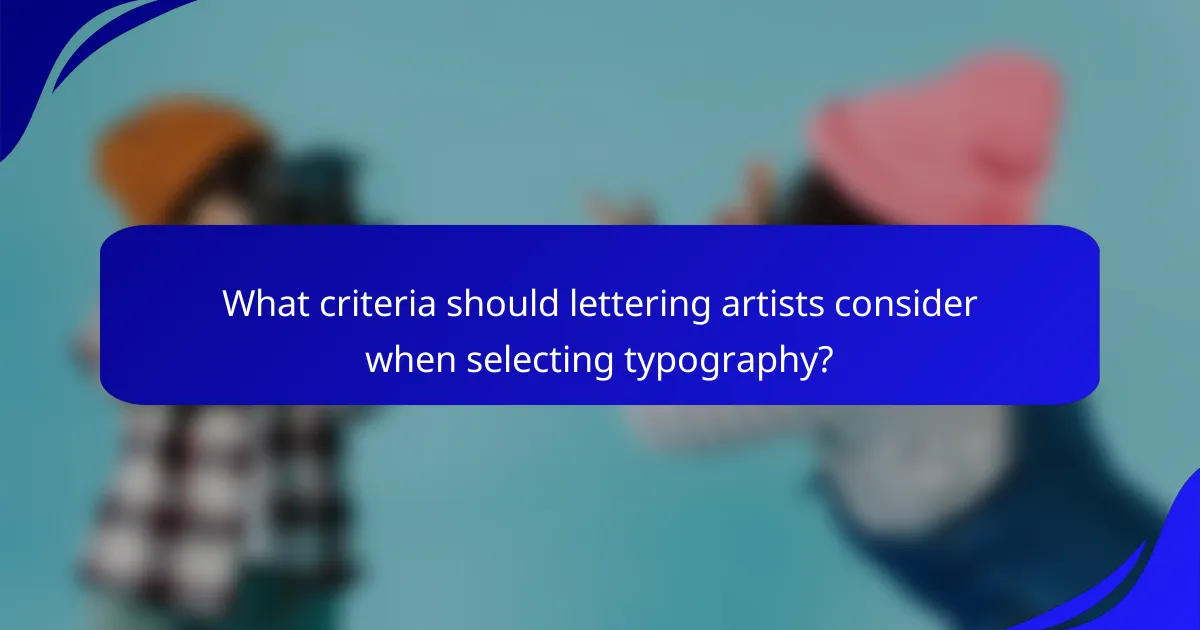
What criteria should lettering artists consider when selecting typography?
Lettering artists should consider factors such as target audience preferences, medium of display, and the emotional impact of typography when selecting typefaces. These criteria help ensure that the chosen typography effectively communicates the intended message and resonates with viewers.
Target audience preferences
Understanding the target audience is crucial for lettering artists. Different demographics may have distinct preferences for style, readability, and emotional resonance. For instance, younger audiences might favor modern, playful fonts, while older demographics may prefer classic, serif typefaces.
Conducting surveys or focus groups can provide valuable insights into audience preferences. Additionally, analyzing competitors’ typography choices can help identify trends and expectations within specific markets.
Medium of display (digital vs. print)
The medium of display significantly influences typography selection. Digital platforms often require fonts that are optimized for screen readability, such as sans-serif typefaces, which tend to be clearer at smaller sizes. In contrast, print materials can utilize a wider variety of fonts, including decorative and serif styles, as they can be more easily read in larger formats.
Consider the context in which the typography will be viewed. For example, a poster displayed from a distance may benefit from bold, large fonts, while a brochure can incorporate finer details and more intricate designs. Always test typography in the intended medium to ensure optimal legibility and impact.
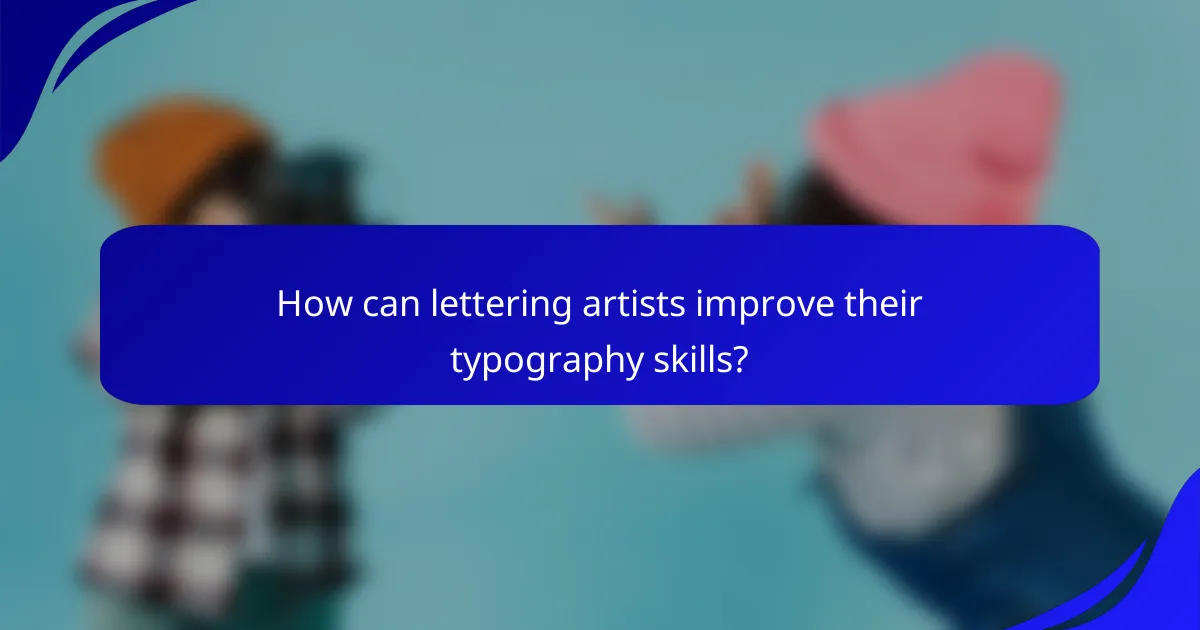
How can lettering artists improve their typography skills?
Lettering artists can enhance their typography skills by actively engaging in practice, studying historical examples, and participating in workshops. These methods provide practical experience, a deeper understanding of design principles, and opportunities for feedback and collaboration.
Practicing with design software
Using design software like Adobe Illustrator or Procreate allows lettering artists to experiment with different typefaces and styles. Regular practice in these programs can help artists refine their skills in layout, spacing, and overall composition.
Start by creating simple projects, such as custom quotes or logos, and gradually increase complexity. Familiarize yourself with tools like kerning, leading, and grid systems to improve readability and visual appeal.
Studying historical typography
Exploring historical typography can provide valuable insights into effective design choices and trends. By analyzing classic typefaces and their applications, artists can understand the emotional impact of different styles and how they resonate with audiences.
Consider visiting libraries or online archives to access resources on typography history. Take notes on how certain fonts were used in various contexts, as this can inspire your own work and help you make informed decisions in your designs.
Participating in design workshops
Attending design workshops offers hands-on experience and the chance to learn from industry professionals. These workshops often cover essential topics such as typography principles, layout techniques, and the emotional aspects of type design.
Look for local or online workshops that focus on lettering and typography. Engaging with peers can also provide constructive feedback and foster a supportive community, which is crucial for growth as a lettering artist.
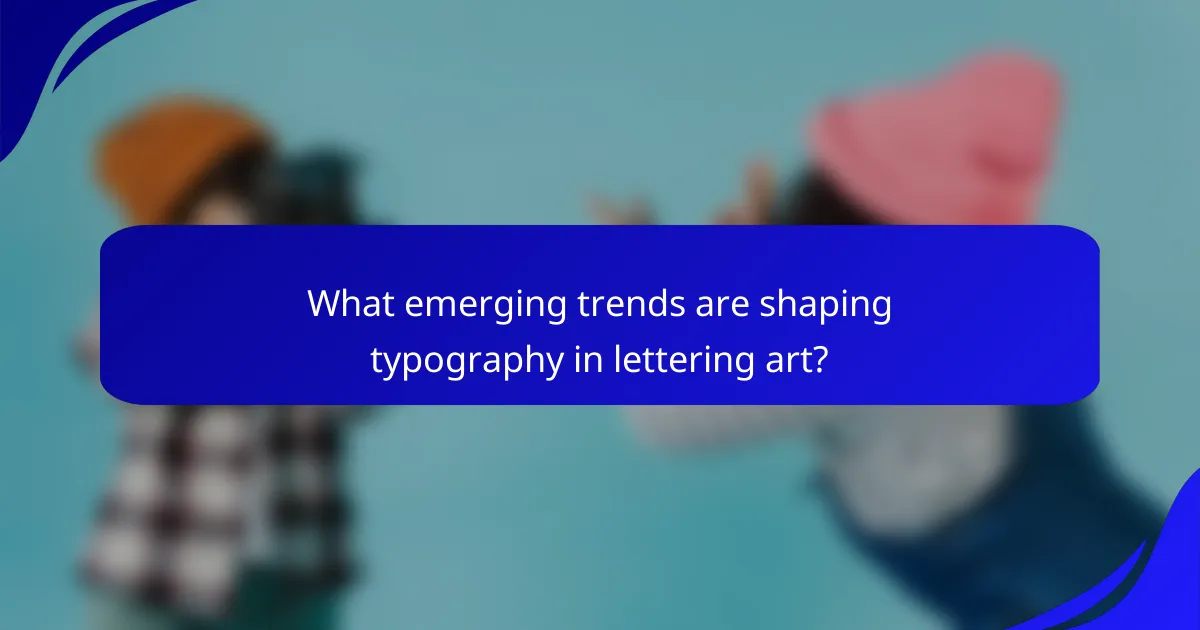
What emerging trends are shaping typography in lettering art?
Emerging trends in typography for lettering art are significantly influenced by advancements in technology and changing design preferences. Key trends include a resurgence of hand-drawn typography, the adoption of variable fonts, and the integration of augmented reality into design practices.
Hand-drawn typography resurgence
Hand-drawn typography is experiencing a revival as designers seek authenticity and uniqueness in their work. This trend emphasizes the personal touch and craftsmanship that digital fonts often lack. Artists are increasingly using tools like tablets and styluses to create custom lettering that resonates with audiences on a more emotional level.
When incorporating hand-drawn typography, consider the context of your design. It works well for brands aiming for a casual or artisanal feel. However, ensure that the style aligns with the overall message and audience expectations to avoid miscommunication.
Use of variable fonts
Variable fonts allow for multiple styles and weights within a single font file, providing flexibility and efficiency in design. This trend simplifies the design process by reducing the number of font files needed, which can enhance website loading times and improve user experience.
When using variable fonts, designers should focus on the range of styles available and how they can be manipulated to fit various design needs. This adaptability can help maintain brand consistency while offering creative freedom. However, ensure that the chosen variable font maintains readability across different devices and screen sizes.
Integration of augmented reality
Augmented reality (AR) is transforming how typography is experienced, allowing for interactive and immersive designs. By integrating typography into AR applications, designers can create engaging experiences that blend the physical and digital worlds, enhancing user interaction with the text.
To effectively use AR in typography, consider the user environment and how the text will be viewed. Ensure that the typography is legible and complements the AR experience. Additionally, keep in mind that not all audiences may have access to AR technology, so provide alternative text options for broader accessibility.
